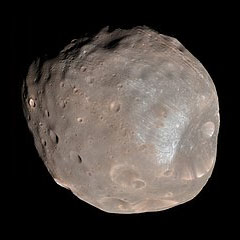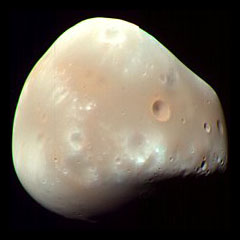Phobos
Phobos, the largest Martian, gouged and nearly shattered by a giant impact crater and beaten by thousands of meteorite impacts, is on a collision course with Mars.
Phobos, named after a messenger of the Roman god of war, is the larger of Mars' two moons and 27 by 22 by 18 km in diameter. It orbits Mars three times a day, and is so close to the planet's surface that in some locations on Mars it cannot always be seen.
Phobos is nearing Mars at a rate of 1.8 meters every hundred years; at that rate, it will either crash into Mars in 50 million years or break up into a ring. Its most prominent feature is the six-mile crater Stickney, its impact causing streak patterns across the moon's surface. Stickney was seen by Mars Global Surveyor to be filled with fine dust, with evidence of boulders sliding down its sloped surface.
Phobos and Deimos appears to be composed of C-type rock, similar to blackish carbonaceous chondrite asteroids. Observations by Mars Global Surveyor indicate the surface of this small body has been pounded into powder by eons of meteoroid impacts, some of which started landslides that left dark trails marking the steep slopes of giant craters.
Measurements of the day and night sides of Phobos show such extreme temperature variations that the sunlit side of the moon rivals a pleasant winter day in Chicago, while only a few kilometers away, on the dark side of the moon, the climate is more harsh than a night in Antarctica. High temperatures for Phobos were measured at -4 degrees Celsius (25 degrees Fahrenheit) and lows at -112 Celsius (-170 degrees Fahrenheit). This intense heat loss is likely a result of the fine dust on Phobos' surface, unable to retain heat.
Phobos has no atmosphere. It may be a captured asteroid, but some scientists show evidence that contradicts this theory.
| Phobos data | |
| Discovery | 08-16-1877 by Asaph Hall |
| Mean distance to Mars | 9,270 km |
| Diameter | 27 × 22 × 18 km |
| Escape velocity | 0.011 km/s |
| Orbital period | 7 hrs 39 min |
| Orbital eccentricity | 0.0151 |
| Orbital inclination | 1.1° |
| Stickney Crater Diameter | 9 km |
Information from: SSE-JPL-NASA,Wikipedia and David Darling's encyclopedia


